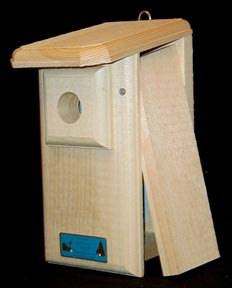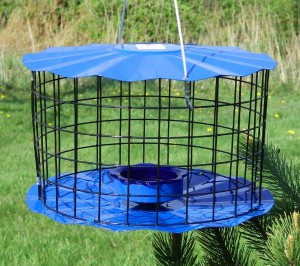Bluebird Basics
Do you remember the first time you saw a Bluebird? It is an unforgettable experience! Sadly, many people today have never even seen one of these beautiful birds. From 1920-1990, the Bluebird population declined by an estimated 90%. There are a number of reasons for this, but the main ones are loss of habitat and competition from other species.

Loss of Habitat – The Bluebird is a cavity nesting bird, which means it prefers to build its nest in a tree cavity. Unlike the woodpecker, however, the Bluebird’s beak is not suited for excavating. It depends on natural cavities, or ones made by other birds. However, with the expansion of cities, and the loss of open space as a result of development, many of the Bluebirds’ natural nesting places have been destroyed.
Competition – The main source of competition for Bluebirds is a bird that is not native to North America – the House or English Sparrow, or HOSP. The house sparrow was introduced to this country in the mid 1800’s. It was thought this bird would help control insect pests. However, those that brought them here seriously underestimated this bird’s fiercely competitive nature. The house sparrow population exploded, while that of the Bluebird declined alarmingly. While HOSPs will nest just about anywhere they can find a nook or cranny to wriggle into, they compete with the more finicky Bluebird, and will often drive away adult Bluebirds, leaving Bluebird nestlings to starve to death. Worse, they will also peck open unhatched Bluebird eggs and kill the babies, or even adults they happen to find sitting on the nest. They have even been known to build their own nests on top of the bodies of the Bluebirds they have killed.
Another source of competition for the Bluebird is the European starling, a bird that is equally aggressive and will also kill both Bluebird adults and young.
Birdhouses are readily available, but not everything called a “Bluebird house” is really suitable for them. Real Bluebird conservation takes a bit of effort, but is well worth it when you see your first clutch of fledglings take flight. Several things to keep in mind when you decide to put up a nestbox for Bluebirds are:
Suitable location – Bluebirds prefer to nest in an area that includes open country, scattered trees, and low sparse ground cover. They do not nest in heavily forested areas. They also do not like land that is completely open (no trees, shrubs, etc.). In areas where there are no house wrens, nestboxes may be mounted near the edge of wooded areas, facing an open field. Where wrens are present, it is best to place the box in a more open location, but one that still provides perches for hunting (such as fences, telephone lines, posts, shepherd’s hooks, etc.) and trees nearby both for shade and to offer the baby birds a safe destination for fledging. Care should be taken not to place the nestbox so close to trees and fences, however, that predators are afforded easy access to the box from above. Keep boxes at least 200 yards from barnyards. Avoid areas with heavy pesticide use. Bluebirds are territorial, so multiple boxes should be placed at least 300 feet apart. An exception is pairing boxes where tree swallows are abundant to allow nesting sites for both species. Some experimentation might be needed to determine the best distance between paired boxes, but success has been noted in boxes paired between 5 and 25 feet apart.
 Proper nestbox – Purchase or build a nestbox designed specifically for Bluebirds. Preferably, these are made of unpainted cedar, pine or redwood. If you must paint your nestbox, it should be painted ONLY on the outside, in a very light color, to avoid overheating. The box should have an overhanging slanted roof, NO perch, and a round entrance hole 1 1/2 to 1 9/16 in diameter. It should have ventilation and drainage holes, be deep enough so predators can’t reach in to get the eggs, and have a door that opens for ease of monitoring and cleaning. In areas of intense summer heat, additional measures should be taken to avoid overheating, such the use of 3/4” lumber, an overhanging roof on all sides, and placement in a location that receives afternoon sun. Avoid placing wren boxes on your property. While wrens are a protected species (meaning that it is illegal to destroy their completed nest, or disturb their eggs), unlike Bluebirds, they do not need help from humans to find places to nest.
Proper nestbox – Purchase or build a nestbox designed specifically for Bluebirds. Preferably, these are made of unpainted cedar, pine or redwood. If you must paint your nestbox, it should be painted ONLY on the outside, in a very light color, to avoid overheating. The box should have an overhanging slanted roof, NO perch, and a round entrance hole 1 1/2 to 1 9/16 in diameter. It should have ventilation and drainage holes, be deep enough so predators can’t reach in to get the eggs, and have a door that opens for ease of monitoring and cleaning. In areas of intense summer heat, additional measures should be taken to avoid overheating, such the use of 3/4” lumber, an overhanging roof on all sides, and placement in a location that receives afternoon sun. Avoid placing wren boxes on your property. While wrens are a protected species (meaning that it is illegal to destroy their completed nest, or disturb their eggs), unlike Bluebirds, they do not need help from humans to find places to nest.
Proper mounting – Nestboxes may be mounted any time, but to attract Bluebirds for their first nesting of the season, they should be in place by early February to mid-March, depending on your geographic location. You may see nestboxes mounted on trees or wooden fence posts. This is not suitable housing for a Bluebird. A Bluebird nestbox should be mounted on a proper post, not on a tree. A natural cavity in a tree is not as obvious a target to a predator as a wooden box. It sticks out like a sore thumb. Predators are very clever. If they have found a meal in one wooden box, they learn to look for more, and if your nestbox is on a tree or fence posts that a predator can climb, you will have placed your Bluebirds in more danger than if you had never offered them a nestbox at all. A mounting post need not be elaborate or expensive. Smooth, round 3/4” electrical conduit is inexpensive and works well, although any smooth scrap round pipe will work. The nestbox should be mounted on the post so that the entrance hole is 5 feet off the ground.
Predator baffles – closely related to proper mounting is installation of a predator baffle on your mounting post. If you’ve ever tried to keep a squirrel out of your bird feeders, you know how resourceful these creatures can be. Other predators are just as resourceful. These include raccoons, foxes, wandering cats, and snakes. A simple predator baffle can be made by using a 2-3 foot section of 8” diameter capped PVC pipe or metal stovepipe with hardware cloth on top, mounted so it wobbles on the post with clamps or hanger straps.
Monitoring – Being a conscientious Bluebird landlord involves more than simply buying or making a nestbox and mounting it in a good location on a proper pole, with a predator baffle. Nestboxes should be monitored at least once a week to be sure that undesirable competitors are not using them. They should also be monitored for blowflies, ants and other parasites, and predator problems. Bluebirds readily tolerate humans monitoring their nestboxes. They will not abandon their young because humans have looked at or touched them. Bluebirds do not have a good sense of smell, so your scent on their nest will not disturb them. The nestbox should not be opened once the hatchlings are 12 days old, as this could cause them to fledge too early. The nestbox should be cleaned out after each batch of babies has fledged.
House sparrow control –The use of a nestbox with the proper size opening will automatically help the Bluebird avoid problems with its European starling competitors. However, an opening of this size will not exclude house sparrows. If you are going to offer a nestbox for a Bluebird, it is necessary to diligently monitor to be sure the box is not taken over by house sparrows. It is better to offer no box at all than to allow house sparrows to reproduce in one. Many people have trouble distinguishing the House Sparrow from other species. The male HOSP has a distinctive black “bib”. The female looks similar to several species of finches and sparrows, but does not have stripes on its breast.

Feeding – while it is not necessary to feed Bluebirds, many people find they enjoy offering treats to their birds, both to help them through times of difficulty, and to have the opportunity to interact more closely with these gentle, trusting creatures. As a general rule, Bluebirds are not attracted to seed feeders. Although they may sometimes be observed eating certain types of seed, their main diet consists of insects and insect larvae, and berries. Some common native berry bushes that Bluebirds enjoy are: Flowering dogwood, Holly, Juniper, Sumac, Mountain-ash, Mistletoe, Hackberry, and Firethorn. Bluebirds sometimes overwinter in places where these plants are abundant. Another food commonly offered to Bluebirds is mealworms. They can be purchased in bulk from several mail-order houses, or obtained locally at bait shops, wild bird supply stores, etc. (Note: NEVER feed earthworms to Bluebirds! They cannot digest them properly, and they will make them very sick.) One caution if you also like to feed other species of birds – do not place your Bluebird nestboxes too close to your wild bird feeding area. Also, feeding cheaper seed “blends” containing corn, milo, and millet, or feeding stale bread, rolls, donuts, etc., will attract house sparrows to your yard, and endanger your Bluebirds. It is better to feed only black sunflower seed, thistle (niger) and fruit to your other birds. Bluebirds also enjoy shallow birdbaths, especially those with a drip/misting feature.
If it weren’t for human intervention, Bluebirds might have been lost to us forever. Happily, as a result of the efforts of concerned people living in neighborhoods just like this one, the Bluebird has begun making a comeback. But there is still much more that needs to be done. Won’t you please join us in helping the Bluebird survive?
Whether you’ve never seen a Bluebird and would like to know how to attract them, have just seen your first Bluebird and would like to learn more about helping them, or have seen many Bluebirds but have never considered trying to help them until now, we invite you to explore our website. The information contained in our FAQ’s, andlinks pages will expand on the brief overview above, and will help you to enjoy this beautiful and well-loved species of native bird.

